Here is a chronological list of the films I saw in 2015 about people surviving and/or being rescued from harsh physical environments and traumatizing psychological prisons
- Wild (Jean-Marc Vallée, 2014)
- Black Sea (Kevin Macdonald, 2014)
- Unbroken (Angelina Jolie, 2014)
- Mad Max: Fury Road (George Miller, 2015)
- Everest (Baltasar Kormákur, 2015)
- The Martian (Ridley Scott, 2015)
- Z for Zachariah (Craig Zobel, 2015)
- Room (Lenny Abrahamson, 2015)
- The 33 (Patricia Riggen, 2015)
- No Escape (John Erick Dowdle, 2015)
- In the Heart of the Sea (Ron Howard, 2015)
And in 2016:
- The Revenant (Alejandro González Iñárritu, 2015)
It’s overwhelmingly apparent that I prefer film stories about people fighting to survive in forbidding natural or socially constructed environments that continuously pound them into submission. Beginning with Black Sea, Kevin Macdonald’s underrated and claustrophobic thriller about a misfit crew of Nazi-treasure hunters aboard a submarine, and continuing straight through to In the Heart of the Sea, director Ron Howard’s ill-fated attempt to bring Melville’s Moby Dick origin story to life, I found myself time and again drawn to films about Nature’s punishing power over all of us and how, in the most extreme of cases, the human spirit and body are put to the ultimate test. Two docudramas came and went this fall, but I couldn’t escape them: Everest, about a deadly tourist expedition to summit the tallest peak in 1996 (you know, the one that writer Jon Krakauer participated in), and The 33, which related the events leading up to the miraculous rescue of the titular Chilean coal-miners trapped inside their workplace for over two months in 2010. As a food film scholar, I was greatly intrigued by a middle sequence in the film, in which the protagonists imagine that their wives, girlfriends, and other loved ones have prepared them a gorgeous feast of home-cooked meals when in reality the miners sit down to tuck in their last heavily rationed “meal” of canned tuna and cookies.

This extreme survival-centered category of film story also indexes other 2015 releases, including post-apocalyptic pictures like George Miller’s instant cult classic actioner Mad Max: Fury Road and the under-seen chamber piece Z for Zachariah. Along with its extreme setting, amidst a community subjugated under one water- and food-controlling dynasty, Fury Road blends in that other narrative thread I love to watch: the rescue film. While the titular character does whatever he can to survive in the desert—even if it means taking the passenger seat and assisting true hero Imperator Furiosa on her quest to save young women from lives spent as sex slaves under her family patriarch—the whole world rallies behind the astronaut Mark Watney, long presumed dead but in actual fact still chugging along as the first pioneer on the Red Planet in Ridley Scott’s crowd-pleasing sci-fi epic The Martian. I wanted to like this film more than I did. Where many saw a hilarious comedy with a captivating lead performance by Matt Damon, I saw a dreadfully unfunny and charmless one-man show starring one of the most overrated actors working today. It didn’t matter, though. I had to see it, as a “hard sci-fi” film fan (more on that in part two) who has dreamed more than once of what life is like elsewhere in the universe.
Of course, I never could have made this observation about my moviegoing preferences and habits if these films hadn’t all appeared at once. What happened this past year (or in the years prior, while these films were in development) that so many films about survival and rescue were released? Are they a response to an underlying fear that this country is turning to shit again, what with the United States entering its fourteenth year of the longest war it has ever waged, the rampant political discord in Congress, the emergence and threat of the Islamic State, and so on? Like the disaster movies of the 1970s, which were so prevalent as to form the genre’s so-called “golden age” as they addressed the anxieties of the Vietnam War, Watergate, and overall distrust of political authority and therefore its inability to keep Americans safe, do the films of 2015 also point to something that is taking place on the national or world stage?

Dystopias like those depicted in Fury Road and even the effective B-movie thriller No Escape, which is set in an unnamed Southeast Asian country and charts one American family’s fight for survival during a violent coup d’etat, have seemingly always been in fashion. However, this cannot explain 2015’s collective fascination with stories of survival and rescue. Most of the films are not dystopian sci-fi pictures. At this time, I cannot offer any full-fledged theory that may explain this phenomenon, only speculation. Aside from their sometimes flashy special effects, these films represented a more conservative style of film storytelling, harkening back to a bygone age of cinema. Beginning with Angelina Jolie’s bloated endurance test Unbroken (released at the end of 2014), which was probably meant to resemble a John Ford, Frank Capra, or William Wyler WWII war movie but actually recalled a Clint Eastwood picture about the triumph of the (American) spirit in the face of (excessive) adversity, this film story trend is meant to induce spiritual and emotional uplift in audiences. Just look at the raging success of The Martian. At times lauded and scrutinized for its diverse cast and for presenting that up-and-coming economic and political threat, China, as a congenial U.S. collaborator, everyone practically guaranteed that filmgoers would leave the theater feeling warm and fuzzy, a little light on their feet. This is a utopian vision of the future of film storytelling, and it is in stark contrast to the cynicism of The Hunger Games and Divergent film franchises and any Avengers or X-Men movie currently showing on a screen near you.
Read the Montage Series, 2015: A Year in Reflection, from the beginning.






